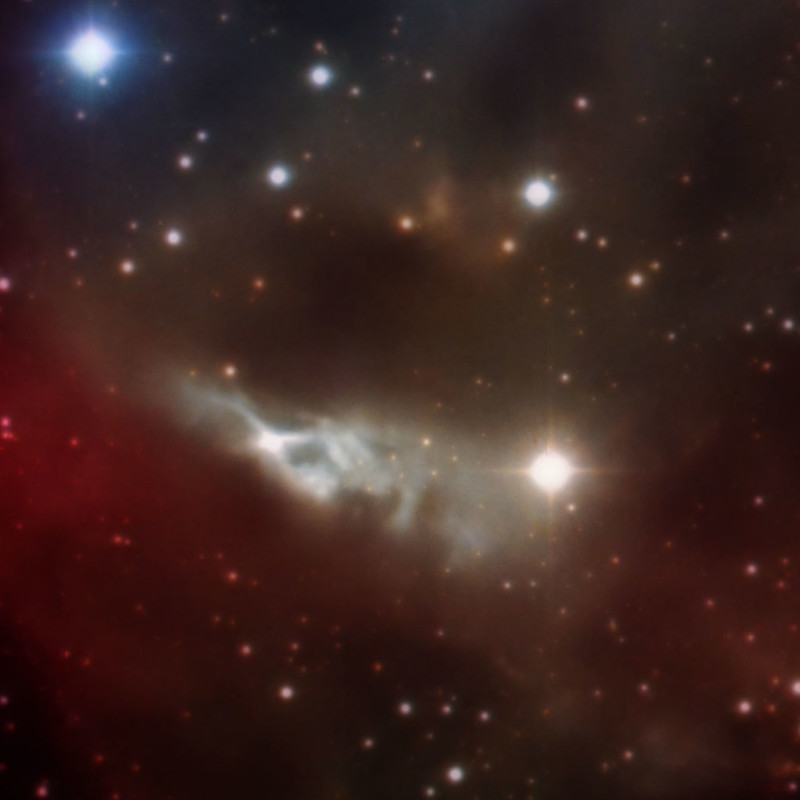by Ann » Thu Sep 15, 2022 4:19 am
AVAO wrote: ↑Wed Sep 14, 2022 9:03 pm
Ann wrote: ↑Wed Sep 14, 2022 6:58 am
So that strange gray translucent thing protruding into the red Lacerta nebula is the end part of a long dust lane, then?
I guess it has been truncated and has had its end part flare out into an arc, almost like a sausage, because of the stellar winds of 10 Lacerta.
Ann
ThanX Ann
I'm unsure about this point. On the left Lick Hα 233 (Markarian 914) is one of the Herbig (1960) Ae/Be stars. It seems he's causing quite a stir around

.
Jac

 https://www.flickr.com/photos/185130090 ... 8/sizes/o/
jac berne (flickr)
https://www.flickr.com/photos/185130090 ... 8/sizes/o/
jac berne (flickr)
Thanks, AVAO, but groan!
"Markarian 914" doesn't sound like a star to me. I asked Simbad Astronomical Database to take me to Markarian 914, and
this is what it said to me: It's a galaxy!
I found your source for the Lick Hα 233 (Markarian 914) thing. It is this:
Taniguchi et al. wrote:
The identification of the Markarian galaxy 914 as Lick H-alpha 233, one of the Herbig (1960) Ae/Be stars, is confirmed by the small radial velocity exhibited in the observations reported. Since the spectral type of Lk H-alpha 233 is about A7, the nebulosity around it is due to reflection. It is noted that, in a Schmidt survey with a low dispersion prism, it is difficult to distinguish Markarian galaxies from nebulous objects in the Galaxy. Radial velocity measurements therefore provide one with reliable judgments.
At least Simbad found an object for me when I asked for Markarian 914. When I asked for Lick Hα 233, Simbad rejected my request.
There may be an Ae/Be star in the bright arc of LBN 437, but if so, I can't find it and don't know its designation.
Can you tell me which of the stars in your picture would be this Ae/Be star? Okay, it's this thing, right? I have to admit it doesn't look much (or anything) like a galaxy to me.

- Possible Ae Be star in LBN 437 in Lacerta nebula AVAO.png (66.68 KiB) Viewed 2036 times
Ann
[quote=AVAO post_id=325846 time=1663189408 user_id=144694]
[quote=Ann post_id=325831 time=1663138687 user_id=129702]
So that strange gray translucent thing protruding into the red Lacerta nebula is the end part of a long dust lane, then?
I guess it has been truncated and has had its end part flare out into an arc, almost like a sausage, because of the stellar winds of 10 Lacerta.
Ann
[/quote]
ThanX Ann
I'm unsure about this point. On the left Lick Hα 233 (Markarian 914) is one of the Herbig (1960) Ae/Be stars. It seems he's causing quite a stir around ;-).
Jac
[img]https://live.staticflickr.com/65535/52358526690_48b8d2921a_c.jpg[/img]
[img]https://live.staticflickr.com/65535/52358342658_3212db38c1_c.jpg[/img]
[size=85][url]https://www.flickr.com/photos/185130090@N02/52358342658/sizes/o/[/url][/size]
[size=85]jac berne (flickr)[/size]
[/quote]
Thanks, AVAO, but groan!
"Markarian 914" doesn't sound like a star to me. I asked Simbad Astronomical Database to take me to Markarian 914, and [url=http://simbad.u-strasbg.fr/simbad/sim-basic?Ident=Markarian+914&submit=SIMBAD+search]this[/url] is what it said to me: It's a galaxy!
I found your source for the Lick Hα 233 (Markarian 914) thing. It is this:
[quote][url=https://ui.adsabs.harvard.edu/abs/1982ApL....23...25T/abstract]Taniguchi et al.[/url] wrote:
The identification of the Markarian galaxy 914 as Lick H-alpha 233, one of the Herbig (1960) Ae/Be stars, is confirmed by the small radial velocity exhibited in the observations reported. Since the spectral type of Lk H-alpha 233 is about A7, the nebulosity around it is due to reflection. It is noted that, in a Schmidt survey with a low dispersion prism, it is difficult to distinguish Markarian galaxies from nebulous objects in the Galaxy. Radial velocity measurements therefore provide one with reliable judgments.[/quote]
At least Simbad found an object for me when I asked for Markarian 914. When I asked for Lick Hα 233, Simbad rejected my request.
There may be an Ae/Be star in the bright arc of LBN 437, but if so, I can't find it and don't know its designation.
Can you tell me which of the stars in your picture would be this Ae/Be star? Okay, it's this thing, right? I have to admit it doesn't look much (or anything) like a galaxy to me.
[attachment=0]Possible Ae Be star in LBN 437 in Lacerta nebula AVAO.png[/attachment]
Ann